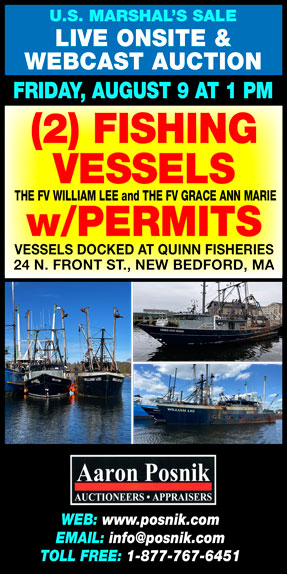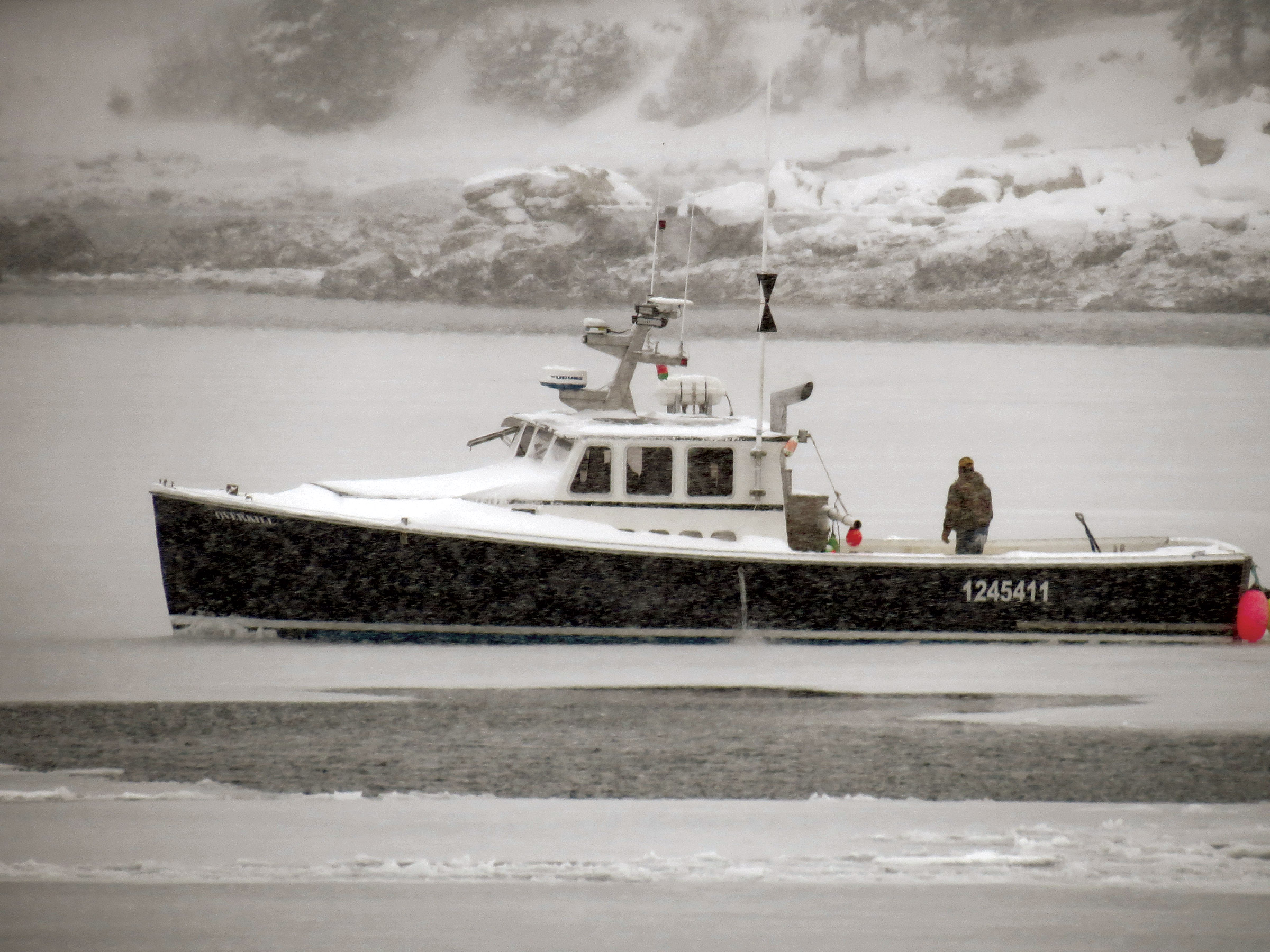
Jimmy Wotton aboard his lobster boat Overkill out in a snowstorm breaking ice. Friendship fishermen tried in vain to keep the harbor and surrounding bay open. I took this shot through the window looking out over my desk. (Diane Cowan photo)
A February to remember
Maine lobsters and lobster scientist iced-in
For those readers who do not know, Diane Cowan, Phd, is the executive director of The Lobster Conservancy, and the author of the popular “Ask The Lobster Doc” column that appeared in Commercial Fisheries News for several years. Cowan made national news recently when her struggles with being iced-in on a coastal island, and essentially cut off from civilization and supplies, resulted in an emergency air drop.
Even for the scrappy Cowan, this winter has posed unique challenges, along with new scientific insight.She has been willing to share her experience and knowledge in this special edition of Ask The Lobster Doc. — Editor
Cover photo: Jimmy Wotton aboard his lobster boat Overkill out in a snowstorm breaking ice. Friendship fishermen tried in vain to keep the harbor and surrounding bay open. I took this shot through the window looking out over my desk. (Diane Cowan photo)
The last time I went to the mainland for a shower and mail was Jan. 30.
I know this because I wrote about it in my journal.
That’s the last time I touched a dollar bill.
Feb. 2, 9 pm. Iced-in.
I know because I went out to check on my boat.
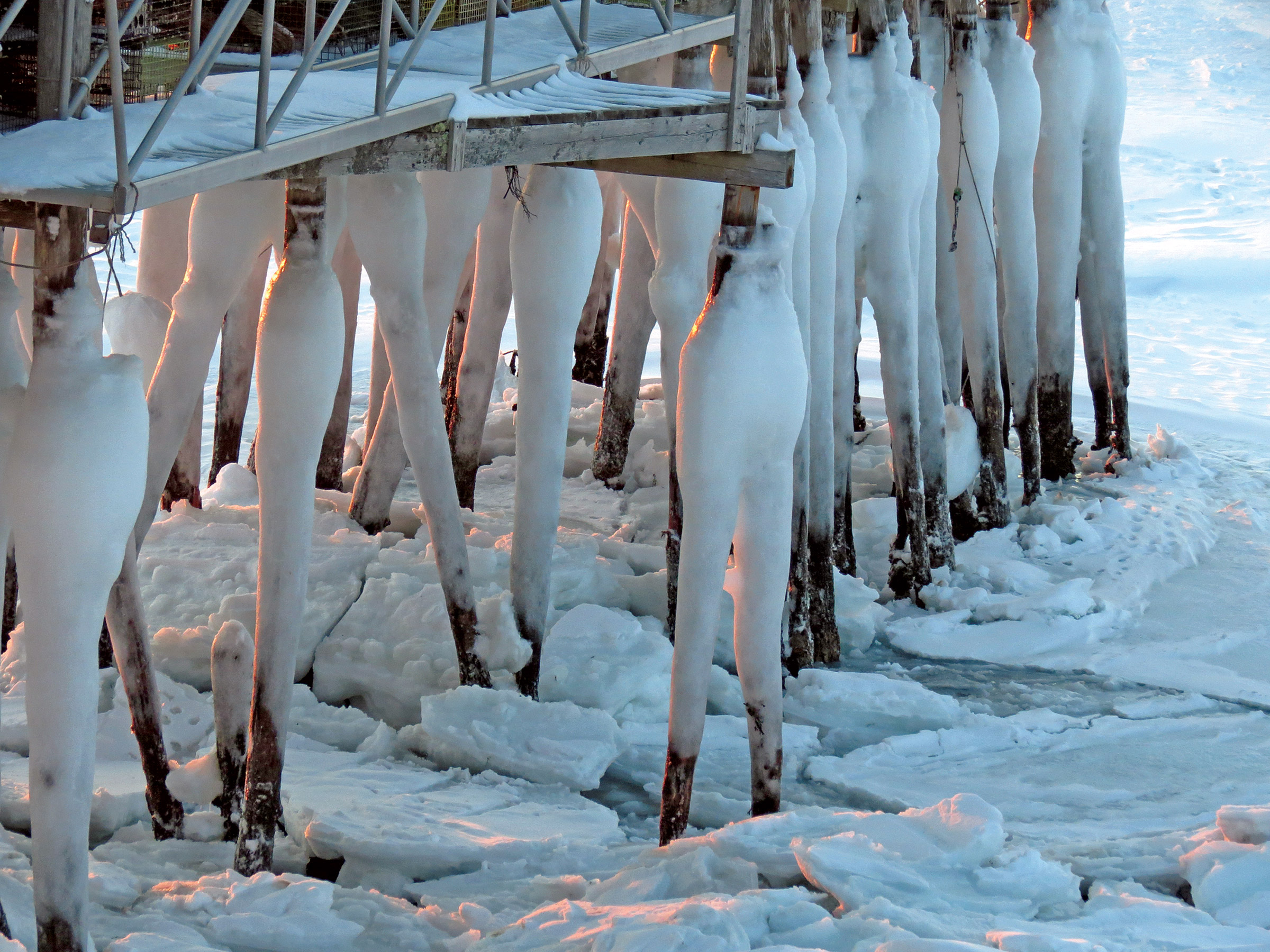
After a while the formations of ice on the pilings of TLC wharf began to look to me like human legs wearing white long-johns. (Diane Cowan photo)
I always told summer people that if I could only be out here on the island for one month of the year, that month would be February – because it is the most aesthetically beautiful month.
So I was here for all of February, and part of March and January, without leaving.
It was the most beautiful thing I’ve ever seen in my life and I wouldn’t trade it for anything in the world.
I didn’t notice until later when someone asked about it, but I too became completely silent.
In the other 15 years I have spent on the island, I have always sung and hummed when I do my chores.
Water songs when I draw water from the dug well.
Wood songs when I split wood.
This year, that stopped.
Not a song out of my soul.
No candles lit.
No dancing with the moon.
Just silence.
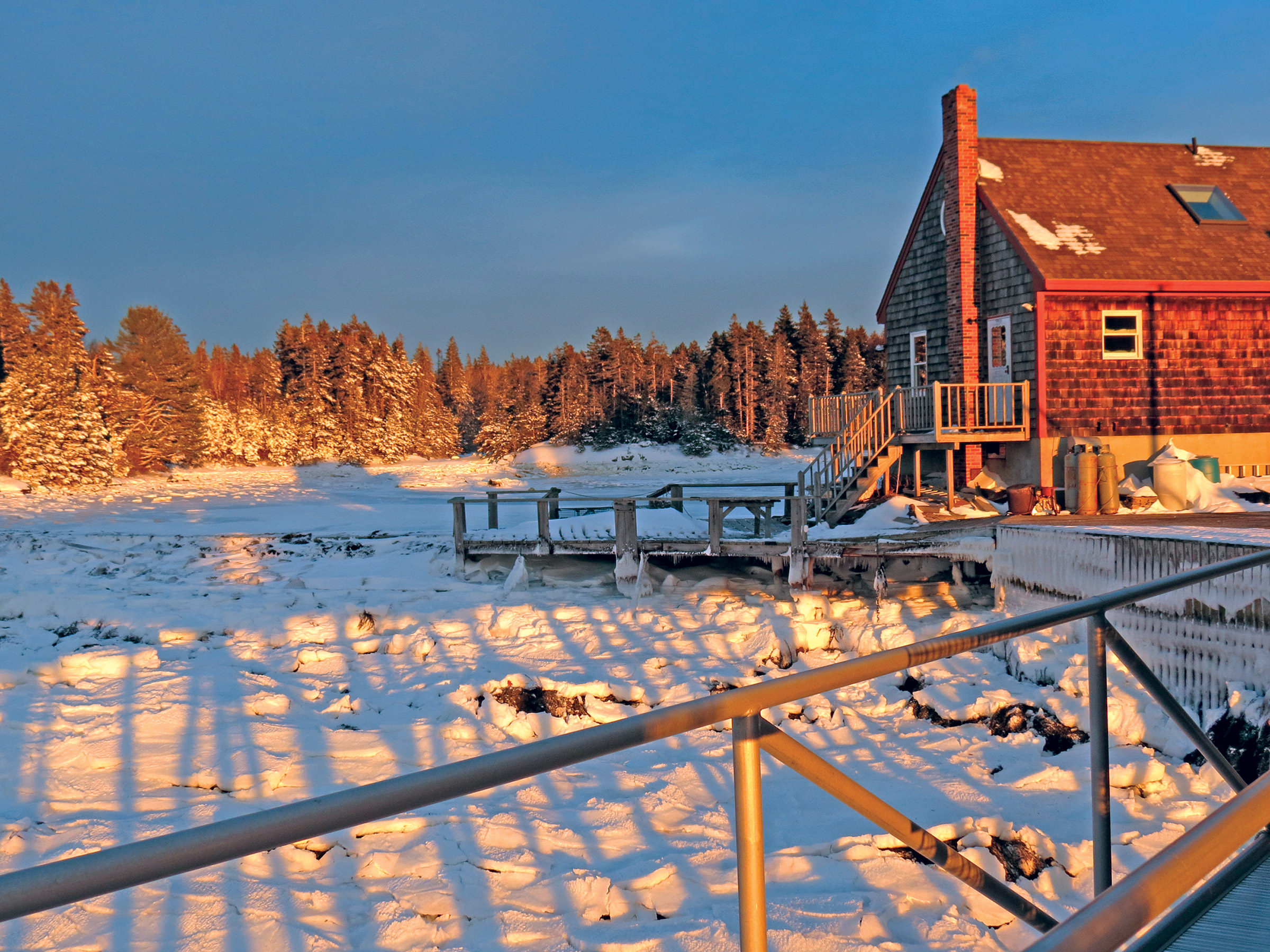
A look at the TLC office/my home, mid-tide at sunset. Note the long February shadows. Just behind the ramp in the foreground is our iced-over lobster pound. (Diane Cowan photo)
That may be the strangest part of this experience.
Me and nature turned silent together.
Mar. 5. Philip Bramhall called to ask if I wanted my mail.
Of course I did!
I’d called the PO when the air drop thing happened and told them not to release my mail to anyone but Philip.
I didn’t want anyone dropping such precious stuff from the sky.
Philip came out and brought my mail, took me to the mainland where I just went straight to my mainland office – took a shower, did a load of laundry (I hadn’t done laundry for two months, and nothing but sponge baths for more than a month), then raided the freezer and cupboards where I’d stocked up so many months before.
I was on the mainland for exactly 1-1/2 hours.
No one saw me (except the guys on the boat and I took portraits of every one of them!).
I didn’t go down a road to a store, or anything “normal” like that.
I came right back here.
It was already more than I wanted for my first initiative back to “reality” – I need to ease back into it slowly.
Okay, that’s enough for now.
Why was I here?
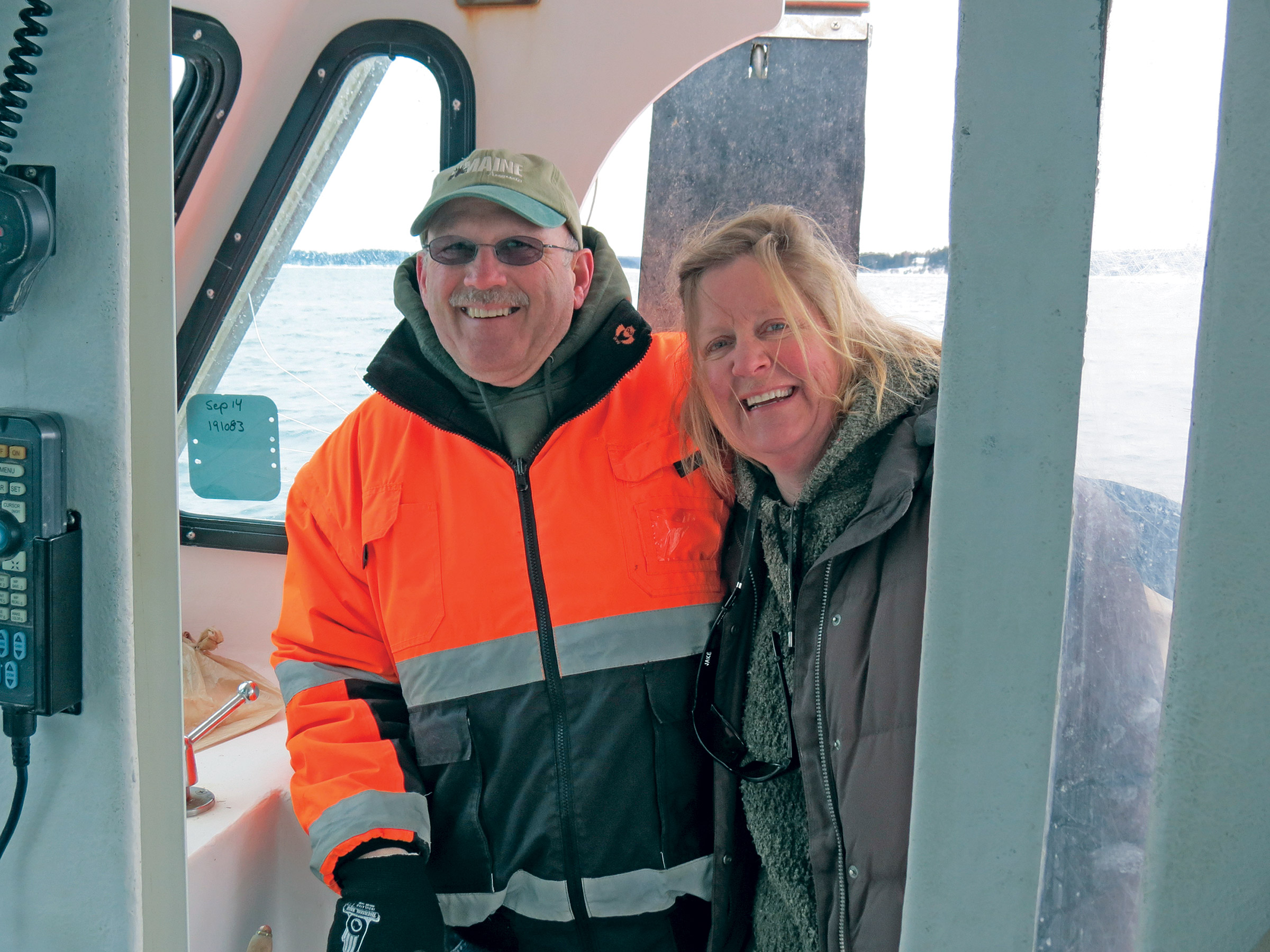
Here I am, on Mar. 5, with the first human I had seen since Jan. 30 – my dear friend and The Lobster Conservancy (TLC) board member Phillip Bramhall. Phillip brought me my mail and ferried me to the mainland for my first trip ashore in a long while. He also went to the store to pick up veggies and cheese for me.
(Jordan Newbert/Sunset Knoll photo)
The lobsters.
Let’s talk about that.
Temperature.
The bottom line is that cold winters are good for lobsters.
The only time I ever really worried about the long-term sustainability of the lobster resource was during the winters of 2006 and 2012 – when not even the lobster pound beside the house where I live iced over.
I thought about throwing ice cubes in the water but knew it would be an exercise in futility.
Lobsters are cold water creatures.
They evolved in cold waters.
Lobsters belong here and rely on cold winters to give up their energy that would be going into feeding and growth, and instead put their energy into reproduction.
Lobsters require cold temperatures to produce eggs and sperm.
Simple logic like that makes me love winter.
No cold, no eggs, no sperm, no future for lobsters.
And, so struggle as we might with the cold, I like looking out my window at frozen water knowing it’s good for lobsters.
In relatively shallow Gulf of Maine waters, bottom waters where lobsters live are warmer than surface waters.
With no one going out lobstering, the lobsters stay on the bottom and are safe and “warm.”
I, on the other hand, have to experience the thermocline every day.
The wood stove in the room where I live is nice and warm, but I have to go outside to the outhouse … where it’s wicked cold.
Activity.
Lobsters can’t warm their bodies using metabolic energy like we do, so lobsters in cold water are cold and inactive.
Good thing, too, because I have to keep feeding the wood stove.
Social behavior.
Thankfully, I have my dog, Sula with me.
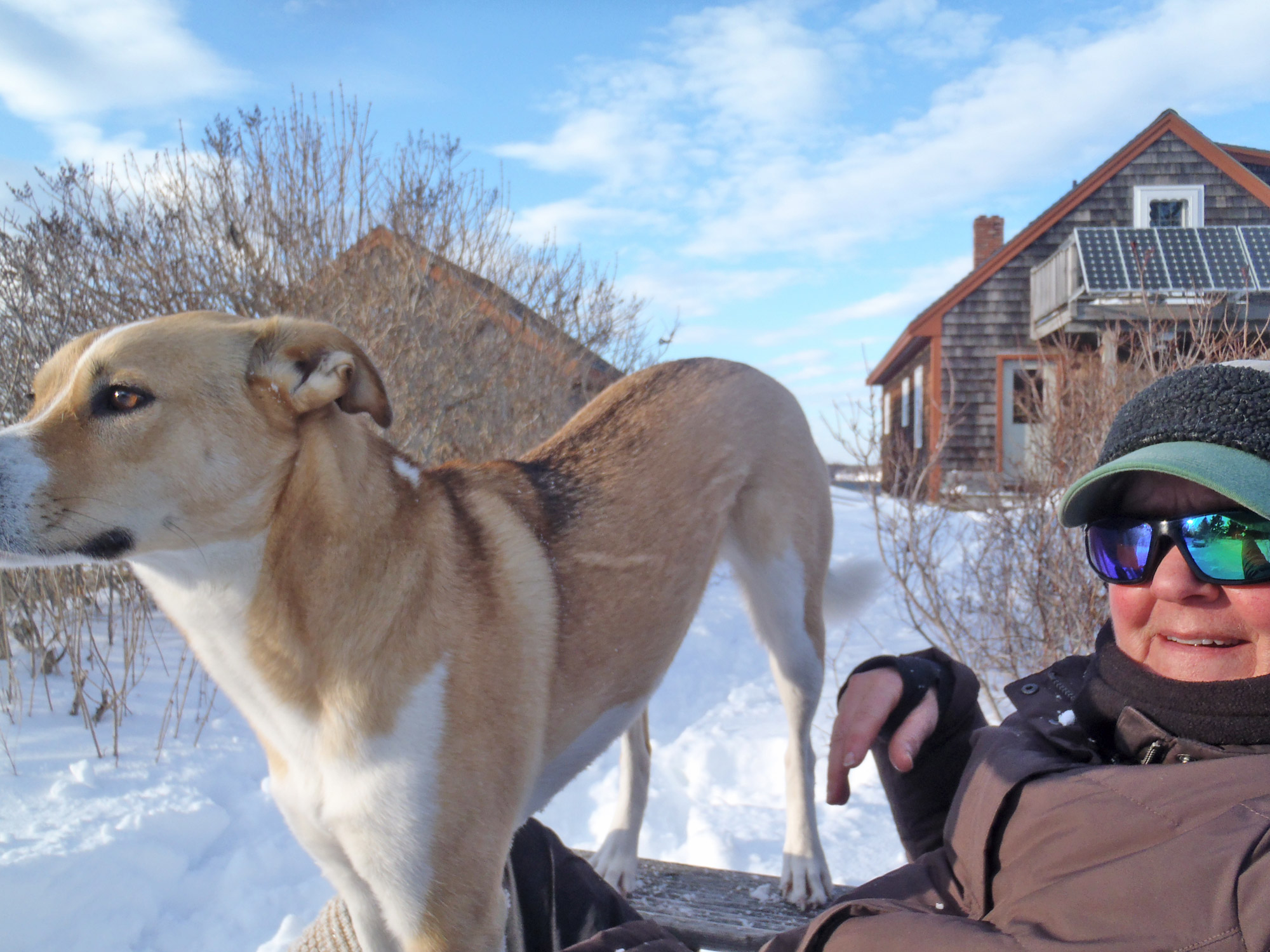
At this point, in late January, Sula and I were still able to spend time in the Adirondack chair – before it became buried deep in snow. (Diane Cowan photo)
Not only does this give me a warm body to cuddle, she makes me stick to some sort of schedule of feeding and grooming.
I also have internet and phone.
Mom and Dad started calling every day.
They never did that before.
That’s how I knew they were a little worried.
I always answered their calls with good cheer in my voice and tales of how beautiful the scenery was and what I was cooking and baking and knitting and sewing.
Stuff like that to make Mom and Dad know I was okay.
As for the lobsters, they did the most astonishing unexpected thing I could ever dream of.
In the lobster pound, beneath the ice, the male lobsters crowded together sharing the coveted mating shelters they so fiercely defended in summer.
Now, this may be the most interesting, startling thing I have ever seen in my life.
Male lobsters share shelters in winter and I think I know why.
They like to hang out together drinking beer and watching football.
Just kidding.
Really.
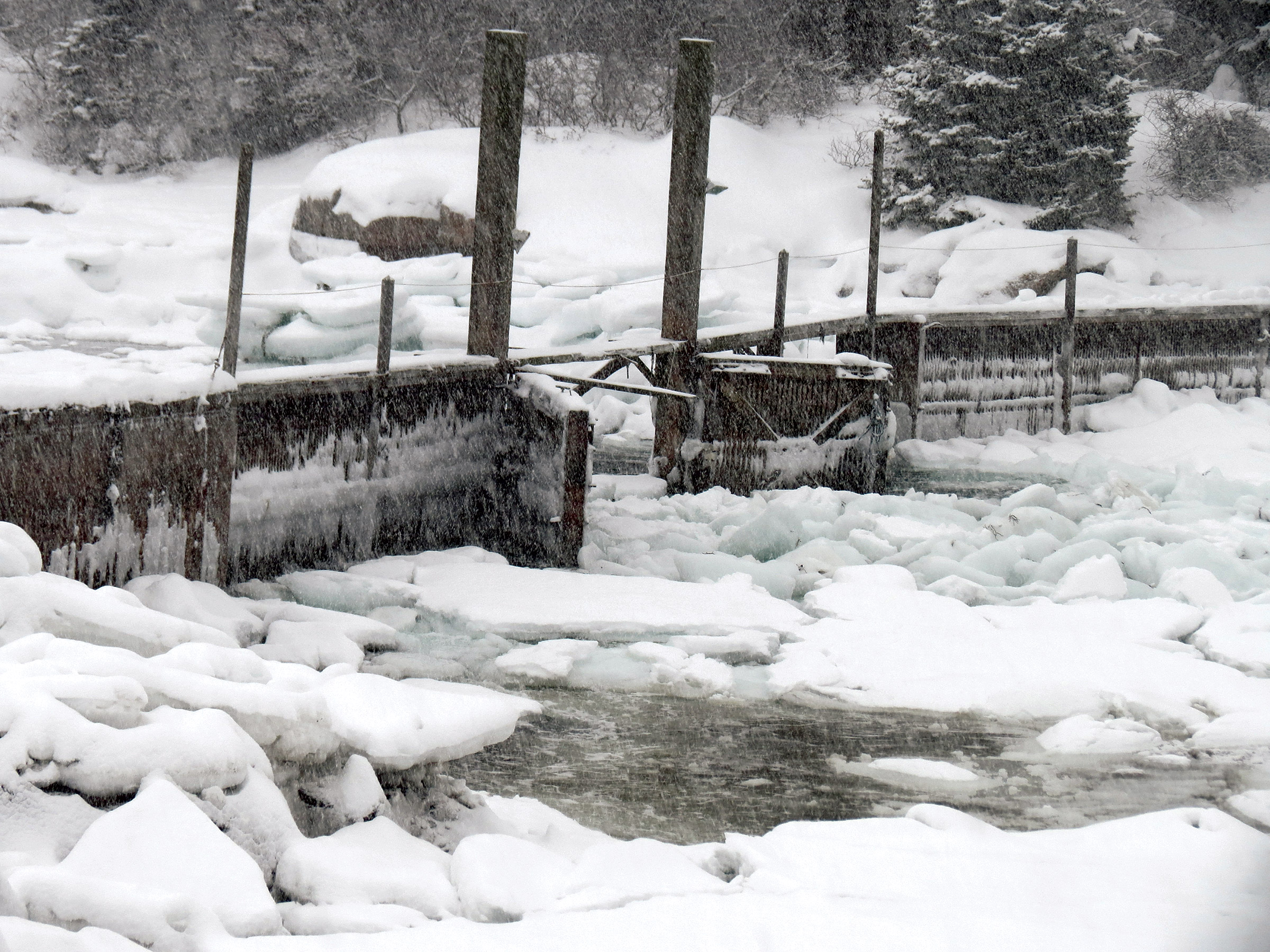
Snow and ice torment the dam at the Friendship Lobster Pound which has been converted to a research center for The Lobster Conservancy. (Diane Cowan photo)
Lobsters in the pound in winter aren’t doing anything at all.
Their bodies are cold and they aren’t feeding (or drinking beer).
They aren’t competing for anything.
I think they hang together, piled up on top of one another, next door to each other, and together under the same rocks because they are preparing for the future.
The dominant male that controls his shelter, and next door shelters, and shelters in an array as far as he can defend during the mating season, lets the other males in for the winter to make sure that when the predators – like river otter and raccoon – come to visit, someone else and not he, will be eaten.
He may also trust that if his and surrounding shelters are occupied they won’t be usurped by crabs or fish or some other interloper.
That’s what I think is going on because come spring the top male won’t allow any of his buddies to hang around, he kicks them out and sets up shop to invite the females in.
Feeding.
No fast food for me, or the lobsters, in winter.
While I spend my time making slow food, the lobsters in the pound don’t feed at all.
Even the ones in deep water, where it may have been warm enough for them to want to eat, probably had to hone their predatory skills instead of going to traps for junk food.
I wonder if the lobsters preying on wild food felt the way I did.
I don’t know if it’s true, but the feasts I made from scratch tasted like the best food ever.
And, based on increased chores and spending exorbitant amounts of energy on brawn-over-brain, I drew fork to mouth with the most wicked hungry appetite imaginable.
And yet, while I ate more than any human can imagine possible, I lost weight and became musclebound.
The overall message?
Cold is good for lobsters.
Lobsters evolved in and belong in cold water.
I now believe the cold is also good for Diane because she knows how to prepare for it and is simply amazed to record and study how lobsters deal with it – something no one in their right mind is trying to do.
Basically, Diane is amazed by lobsters and happy to be iced in with her lobsters so she can study them – uninterrupted by all the silly stuff most people worry about.
By the way, when I dive in the pound in winter, I call my friend Philip Bramhall to tell him what time to expect me to emerge from the water again.
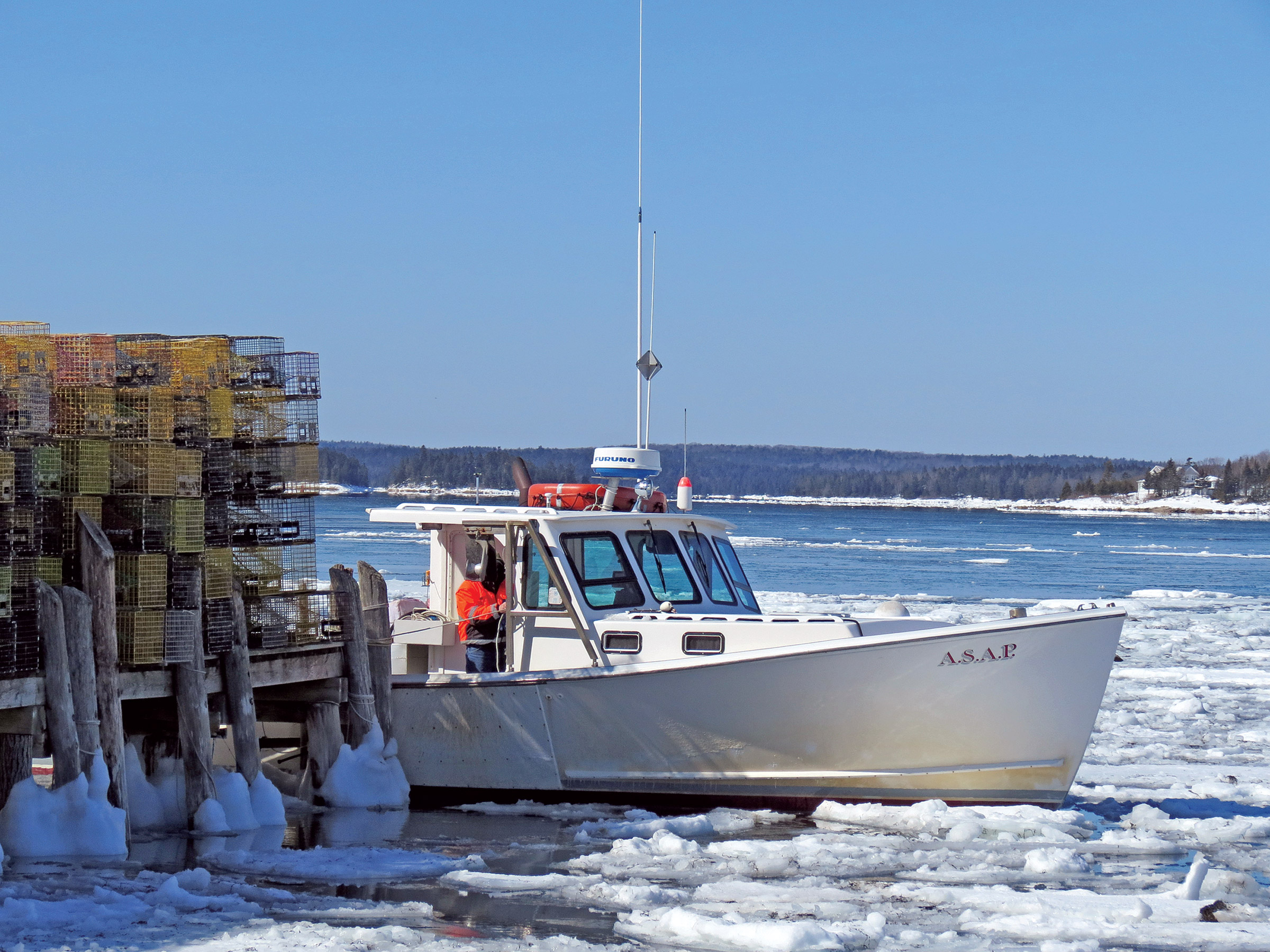
Phillip ties his boat A.S.A.P. to the end of TLC wharf; a welcome sight. The boat is named after his daughter Amanda, wife Susan, daughter Ali, and himself: A.S.A.P. (Diane Cowan photo)
If I don’t call, the plan is that he will get to me before the tide comes and washes me away.
I couldn’t go in this winter because of all the ice, so I have told you about the winter from what I know from diving in the pound other years.
Hope that’s okay. Poetic license, right?
The stuff I told you about me and the lobsters is all true.
Diane Cowan, PhD, is executive director and senior scientist, The Lobster Conservancy, <www.lobsterconservancy.org>.
This column provides lobster health and handling information.
If you have questions or concerns, contact Cowan at (207) 542-9789 or e-mail <dcowan@lobsters.org>


